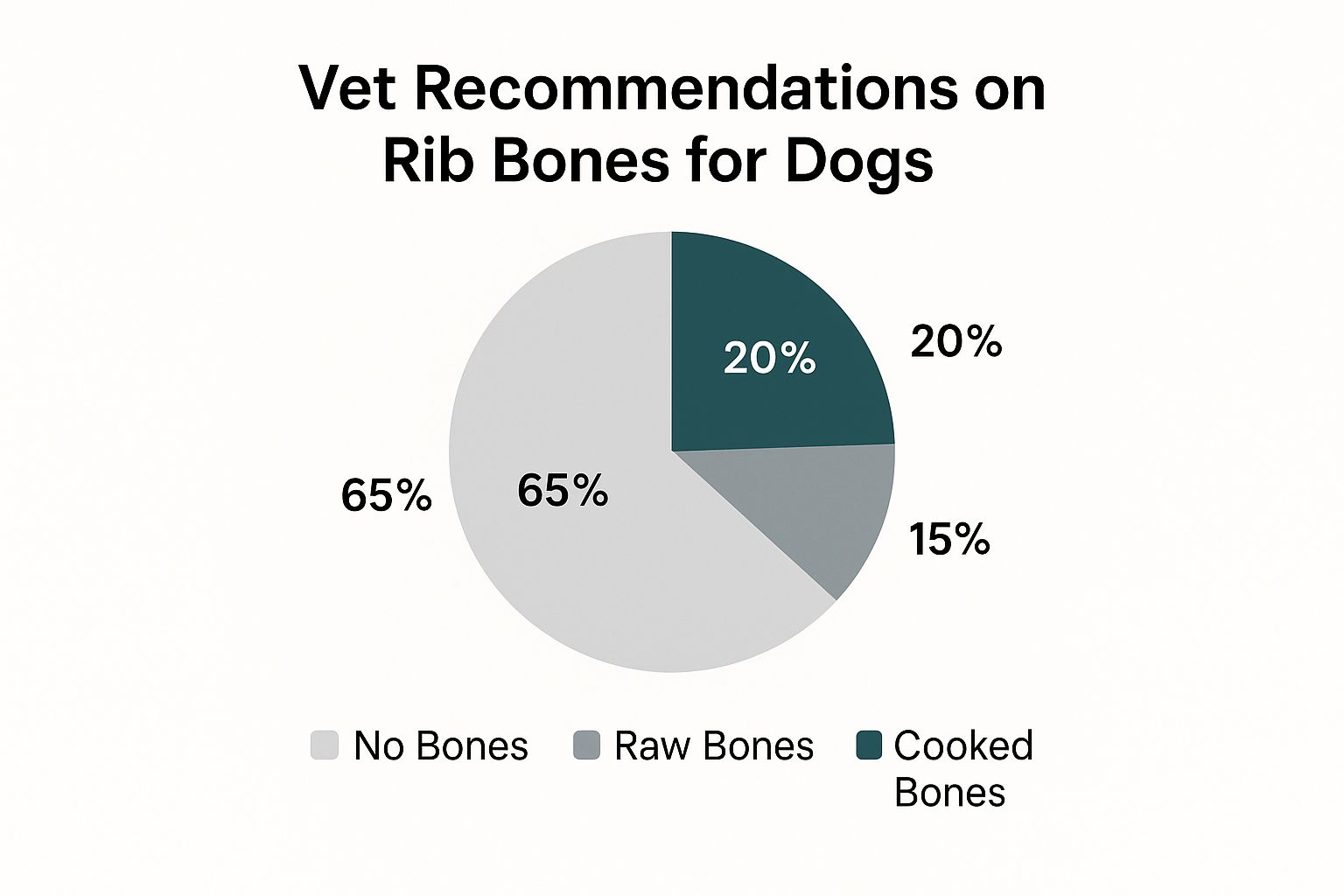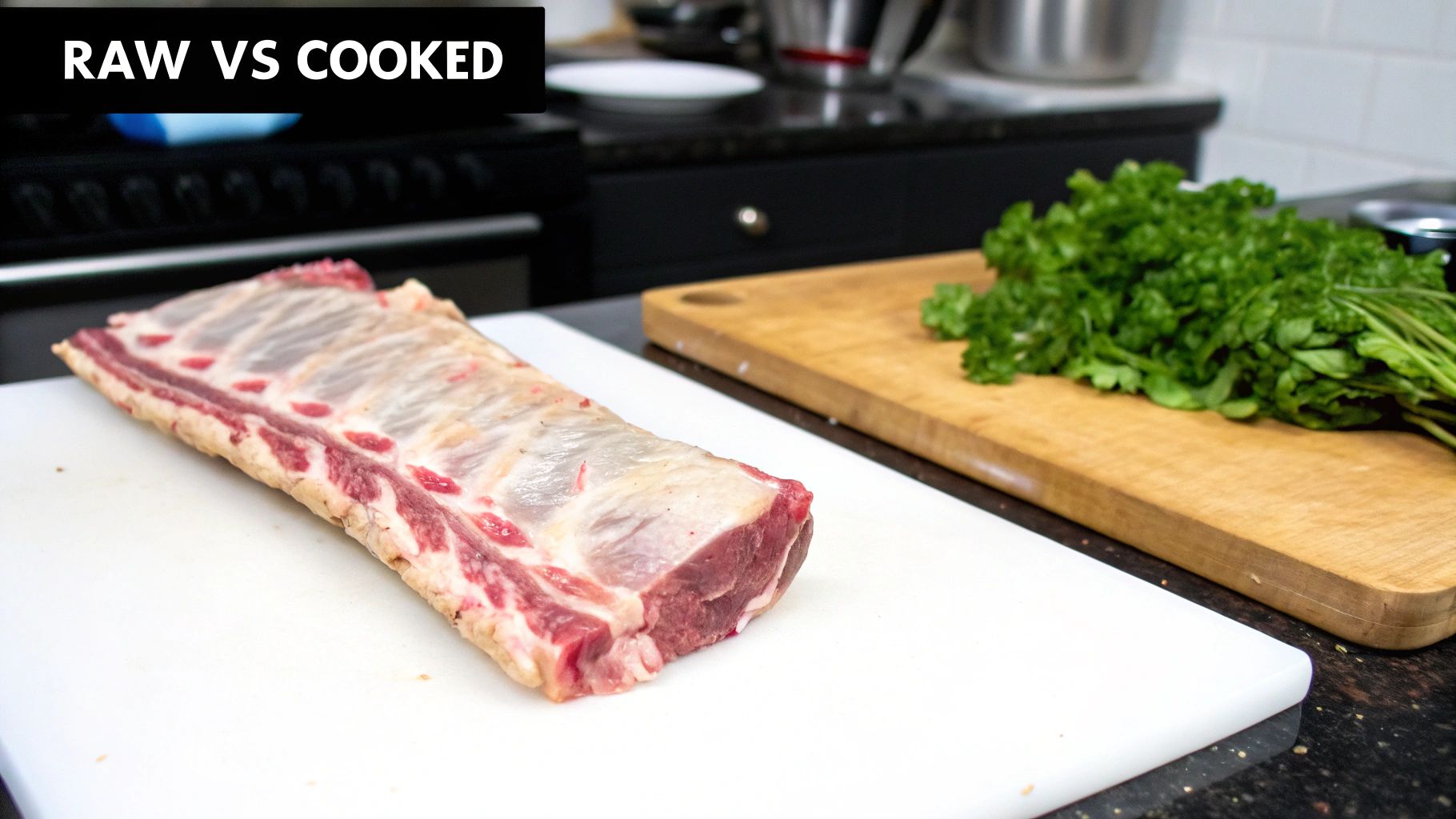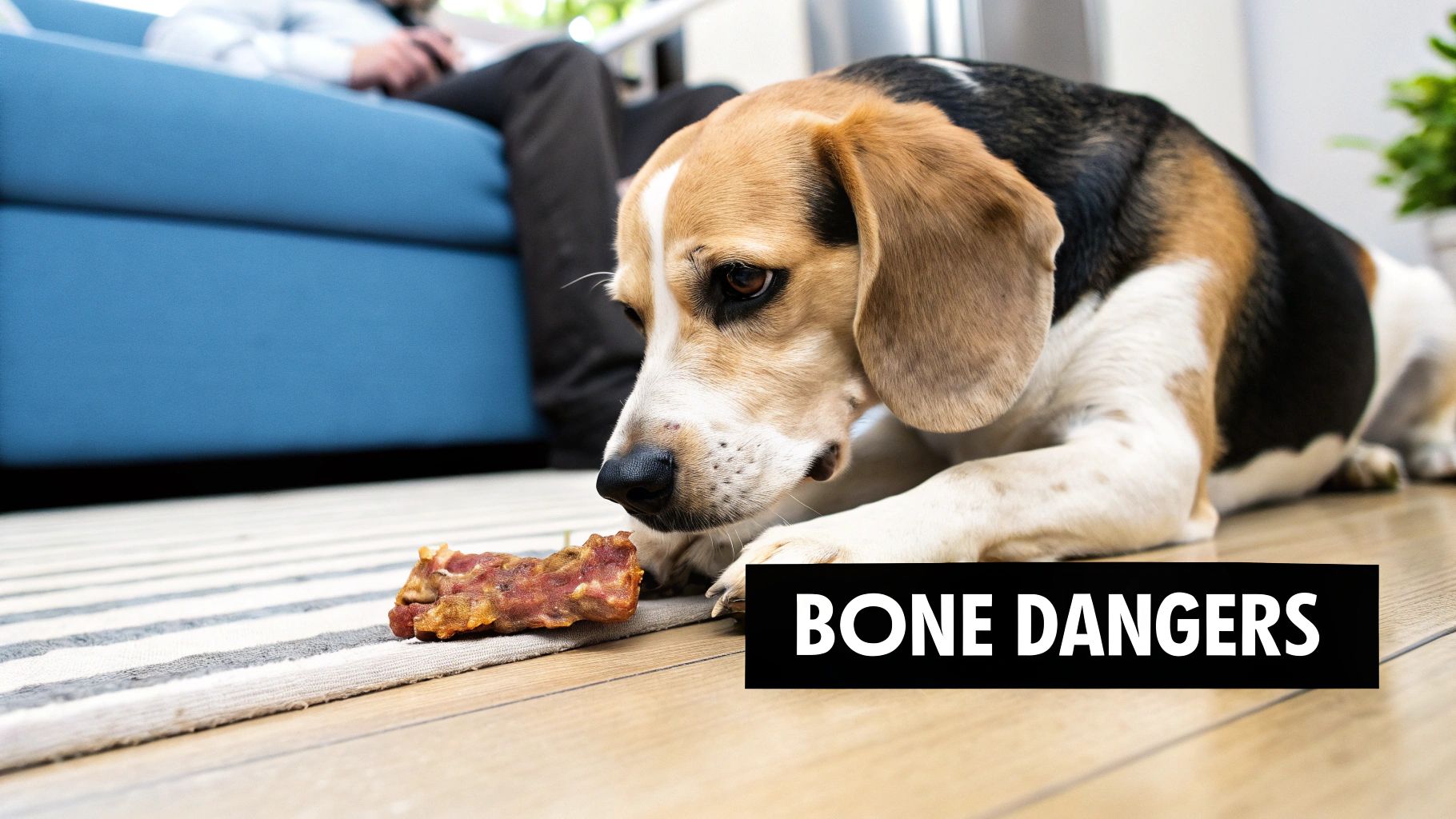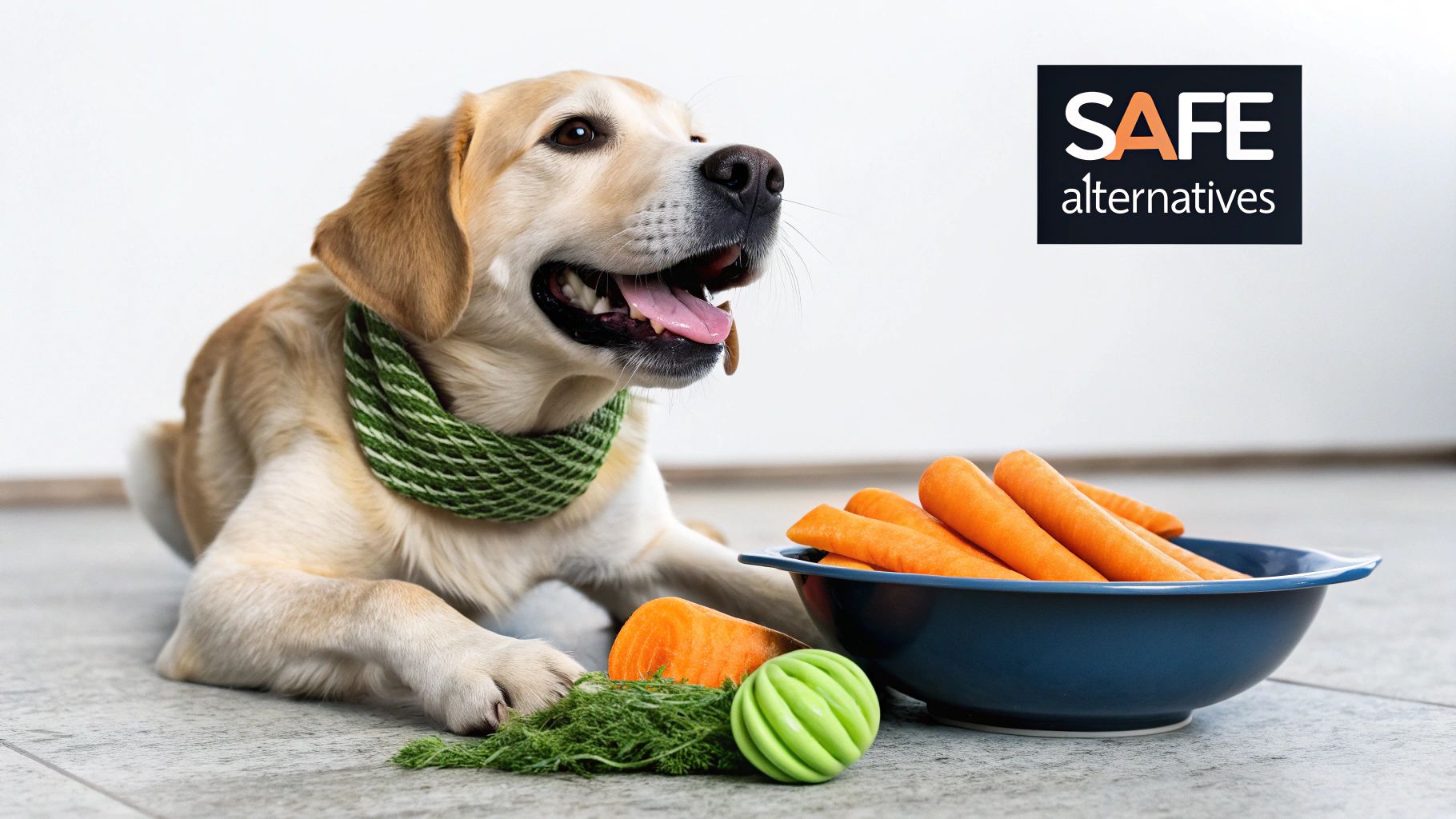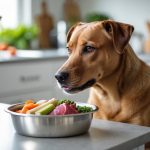It’s a scene many of us know well: you’re clearing the plates after a lovely Sunday roast, and your dog is giving you that look. You know the one. Their eyes flick between you and the leftover rib bones, full of hope. As a loving dog owner, your first thought might be to share the spoils. But when we get down to the question, “can dogs eat rib bones?” the safest and most direct answer is no, especially when they’re cooked.
Getting to the Heart of the Matter with Rib Bones
We’ve all felt that urge to give our dogs a special treat, and it always comes from a place of love. You just want to see them happy, and what could be more satisfying for a dog than a real bone? This, however, is one of those moments where what seems like a harmless treat is actually packed with hidden dangers. Understanding why vets so strongly advise against them is key to protecting the furry family members we care so much about.
The real problem isn’t just about bones in general; it’s about rib bones specifically and, crucially, whether they’ve been cooked or not. The cooking process—be it grilling, roasting, or boiling—completely changes a bone’s structure. It dries them out, making them brittle and much more likely to splinter into sharp, dangerous shards when your dog starts chewing.
Why Vets Are So Cautious
Try to think of a cooked rib bone less like a sturdy chew toy and more like a fragile piece of glass. When your dog crunches down on it, the bone can shatter. These sharp fragments pose a serious threat as they make their way through your dog’s delicate digestive system.
The consensus among veterinary professionals is crystal clear, and it’s based on preventing emergencies they see far too often. The following chart gives you a quick visual on the general advice we hear from vets about feeding bones to dogs.
As you can see, the vast majority of veterinary advice points towards avoiding bones altogether to prevent potential harm.
This isn’t about being overly dramatic or cautious for the sake of it; it’s about making an informed choice for your dog’s wellbeing. The risks tied to cooked bones, in particular, are just too high to justify that fleeting moment of enjoyment. We know you want what’s best for your companion, and sometimes, that means saying no to those pleading eyes for their own safety.
Quick Safety Check Cooked vs Raw Rib Bones for Dogs
To put it simply, not all bones are created equal. The biggest difference lies in whether a bone is cooked or raw. Here’s a quick table to help you see the risks at a glance.
| Bone Type | Risk Level | Primary Dangers |
|---|---|---|
| Cooked Ribs | High | Splintering, choking, internal punctures, blockages. |
| Raw Ribs | Medium to High | Bacterial contamination (Salmonella), choking, dental fractures. |
While some raw-feeding advocates might argue for raw bones, even they come with significant risks that we need to be aware of. Ultimately, the safest choice is to avoid them entirely. There are plenty of safer alternatives that will make your dog just as happy without putting them in harm’s way.
Why Cooked Rib Bones Are a Serious Danger
We’ve all been there. You’ve just finished a fantastic Sunday roast or a summer barbecue, and the leftover rib bones are sitting on the plate. Your dog is giving you that look, and it feels almost mean not to share. But this is one of those moments where being a responsible pet parent means saying no.
Let’s get right to the heart of it. The second a bone is cooked, its entire structure changes. A raw bone has a certain amount of give and flexibility, a bit like a sturdy green tree branch. A cooked bone, on the other hand, is like a dry, brittle twig. The heat dries it out completely, making it incredibly fragile.
When your dog crunches down on a cooked rib bone, it doesn’t just wear down. It shatters. It can easily splinter into sharp, dagger-like shards. We’re not being dramatic—this is simply the physics of what happens in your dog’s mouth.
The Journey of a Dangerous Splinter
Once those splinters are formed, they start a perilous journey through your dog’s body. Every single part of the digestive tract is soft and vulnerable, and these sharp fragments can cause immense pain and life-threatening damage at every step.
Here are the most critical risks you need to know about:
- Mouth and Tooth Injuries: The very first crunch can fracture a tooth or cut the gums and tongue, long before the bone is even swallowed.
- Choking Hazard: A piece can break off and get stuck in your dog’s airway. This is an immediate, terrifying emergency.
- Oesophageal Tears: If a sharp piece does get swallowed, it can scrape or even puncture the oesophagus on its way down.
- Stomach and Intestinal Perforation: This is one of the gravest dangers. A splinter can pierce the wall of the stomach or intestines, causing internal bleeding and a severe infection called peritonitis.
“A cooked bone can become a weapon inside your dog’s body. The risk of splintering and causing a painful, costly, and potentially fatal internal injury is simply too high to ever be considered a safe treat.”
This isn’t just a theoretical worry. Vets across the UK see these entirely preventable injuries far too often.
A Vet-Backed Warning
The advice from the veterinary community is unanimous and crystal clear: stay away from cooked bones. In fact, a leading institution like The Royal Veterinary College in the UK reports that swallowing cooked bones is a top reason for emergency visits due to choking or gastrointestinal blockages. The potential for a splintered rib bone to cause septic peritonitis is a massive concern that drives this strong advice.
It’s tough to resist those puppy-dog eyes, we get it. But knowing this, you can feel confident that you aren’t depriving your dog; you’re protecting them. Your love is shown not by sharing a dangerous scrap, but by making sure they stay safe, healthy, and by your side for many more years to come.
The Truth About Raw Rib Bones
So, we’ve established that cooked bones are a definite no-go. The natural next question is, what about raw ones? You’ve probably heard people in the park or advocates of raw feeding say that raw rib bones are the superior, “natural” choice for dogs. The logic seems sound: they’re softer, less likely to splinter, and closer to what a dog’s ancestors ate in the wild.
And there’s some truth to that. Raw bones are certainly more flexible than their brittle, cooked cousins. When your dog gets to work on one, it’s more likely to be ground down instead of shattering into razor-sharp fragments. But let’s be honest with ourselves—this doesn’t make them risk-free.
Thinking about feeding raw bones means we need to take a step back and look at the whole picture. It’s not a simple yes or no, and it comes with a hefty dose of responsibility and a list of risks we need to talk about openly.
Potential Benefits of Raw Bones
For many dog owners, the appeal of raw rib bones lies in the potential perks they offer. These aren’t just old wives’ tales; there are some genuine benefits that get people interested.
- Dental Health: The simple, abrasive action of chewing a raw bone can be fantastic for a dog’s teeth. It helps scrape away plaque and tartar, promoting healthier teeth and gums. You can think of it as a natural, rugged toothbrush.
- Mental Stimulation: Chewing is a deeply enriching and instinctual activity for dogs. It’s a brilliant way to bust boredom, soothe anxiety, and give them a positive outlet for all that canine energy. A solid chew session can tire a dog out just as much as a long walk.
- Nutritional Value: Raw bones contain marrow and other tissues that are packed with calcium, phosphorus, and other essential minerals.
However, these benefits have to be weighed carefully against some very real dangers. To get a better feel for the philosophy behind this, it’s worth exploring the full picture of a raw food diet for dogs.
Even if the bone itself is less likely to splinter, the risks just shift. Instead of structural failure, we’re dealing with biological and physical hazards that are every bit as serious.
The Undeniable Risks of Raw Ribs
This is where the conversation gets serious. Handing your dog a raw rib bone isn’t something to do on a whim. UK veterinary advice, for example, is still quite cautious. While some experts might agree that large, raw beef ribs can be okay for supervised chewing, they are quick to point out that no raw bone is completely safe.
Here are the key dangers you absolutely must consider:
- Bacterial Contamination: This is a big one. Raw meat and bones can be crawling with nasty bacteria like Salmonella, E. coli, and Listeria. These pathogens are a threat not just to your dog, but to every human in your home through cross-contamination of kitchen surfaces, floors, and even your dog’s kisses.
- Dental Fractures: Softer than cooked bones? Yes. Soft? Absolutely not. Raw bones are still incredibly hard, and a powerful, enthusiastic chewer can easily crack or break a tooth. This leads to excruciating pain and a very expensive trip to the veterinary dentist.
- Pancreatitis: Rib bones, particularly those with a lot of rich marrow, are extremely high in fat. For some dogs, especially those not used to it, a sudden high-fat treat can trigger pancreatitis—a painful and potentially life-threatening inflammation of the pancreas.
- Choking and Blockages: Just because a bone is raw doesn’t mean it can’t be a choking hazard. If a chunk breaks off or your dog tries to swallow a large piece, it can get stuck. These pieces can cause dangerous and agonising blockages in the oesophagus, stomach, or intestines, often requiring emergency surgery.
What to Do If Your Dog Snatches a Rib Bone
It happens in a flash. You turn your back for a second, and that rib bone you left on the plate is gone. Your heart leaps into your throat as a wave of panic washes over you. We’ve all felt that jolt of fear when our dogs get into something they shouldn’t.
First, take a deep breath. Panicking won’t help your furry friend. The most important thing you can do right now is stay calm and act methodically. This isn’t the time for blame or worry; it’s time for a clear-headed action plan. We’re here to walk you through it, step-by-step.
One crucial point: do not try to make your dog vomit. A bone, especially a sharp, splintered cooked one, can do just as much damage coming back up as it did going down. The best first step is to get any other hazards out of reach and then just watch your dog closely.
Monitoring Your Dog in the First 24-48 Hours
The next two days are a critical window. Your job now is to be a watchful guardian, paying very close attention to any changes in your dog’s behaviour or physical state. Many dogs will pass a small bone fragment without any trouble, but you absolutely must watch for signs that something is wrong.
Here are the key symptoms to look out for:
- Lethargy or Weakness: Is your dog unusually tired, listless, or just not interested in their favourite toys or a walk?
- Vomiting or Retching: Any attempt to be sick, especially if nothing comes up, is a major red flag.
- Straining to Poo: If they’re having a hard time or seem to be in pain when trying to go to the toilet, it could signal a blockage.
- Bloated or Tense Abdomen: A swollen, hard, or painful belly is an emergency sign. Don’t hesitate.
- Loss of Appetite: Turning their nose up at food or water is a clear signal that your dog isn’t feeling well.
- Signs of Pain: Whining, restlessness, or yelping when you touch their stomach are all cries for help.
Your intuition as a dog owner is your most powerful tool. If you just feel that something is “off” with your dog, trust that instinct. It’s always, always better to be overly cautious than to wait until a minor issue becomes a major emergency.
When to Call the Vet Immediately
Knowing when to monitor at home versus when to rush to the vet is crucial. If your dog swallowed a cooked rib bone, or if you notice any of the serious symptoms listed above, you need to call your vet right away. A blockage or internal tear is a life-threatening emergency that requires urgent professional care.
Your vet can give you specific advice based on your dog’s size, the type of bone, and the symptoms they’re showing. For ongoing guidance on keeping your pet healthy, you can find more information in our resources on general dog health and care. Being proactive is always the best approach.
Safe and Happy Chewing Alternatives for Your Dog
Now that we’ve established why rib bones aren’t the kindest choice for our dogs, you might be thinking, “So what can I give them instead?” It’s a fantastic question. We all know that chewing is a natural, healthy, and incredibly important activity for our dogs. It keeps their minds busy, their jaws strong, and their teeth clean.
The great news is that just because rib bones are off the menu, it doesn’t mean the joy of chewing has to end. There’s a whole world of safe, satisfying, and vet-approved alternatives out there that provide all the fun without any of the frightening risks. Our goal is to find that perfect option to keep your companion happy and engaged.
Let’s explore some of the best choices available, so you can confidently treat your dog to something they’ll love.
Durable Toys for Power Chewers
For dogs who love a good, long-lasting challenge, durable chew toys are a brilliant solution. These are designed specifically with safety and longevity in mind, standing up to even the most enthusiastic chewers.
- Tough Rubber Toys: Brands like KONG have become household names for a reason. Their classic rubber toys are not only tough but can be stuffed with treats, peanut butter, or your dog’s kibble. This turns a simple chew session into an enriching puzzle, providing mental stimulation that can help reduce boredom and anxiety.
- Durable Nylon Chews: These toys are engineered to be incredibly resilient. They come in various shapes, sizes, and even flavours to keep your dog interested. As your dog chews, tiny bristles are raised on the toy, which act like a toothbrush to help clean their teeth.
It’s all about channelling that natural chewing instinct into a safe and constructive activity. A good chew toy is like a good puzzle; it engages their mind and body in a positive way, leaving them content and tired.
Natural Chews and Dental Treats
If you’d prefer to offer something more natural, there are many excellent options designed to be both delicious and safe for your dog.
- Dental Chews: Specifically formulated to promote oral health, dental chews are designed to reduce plaque and tartar buildup as your dog chews. Many are approved by veterinary oral health councils, giving you extra peace of mind. They are a fantastic way to support your dog’s dental hygiene between professional cleanings.
- Edible Natural Chews: Items like bully sticks, beef tendons, or specific vegetable-based chews can be great alternatives. They are fully digestible, which eliminates the risk of blockages associated with bone fragments. Always supervise your dog with any edible chew to ensure they don’t try to swallow large pieces.
Choosing the right chew is an essential part of your dog’s overall wellbeing. It’s a key component of their daily enrichment and plays a big role in their diet. For more insights into creating a balanced and healthy lifestyle for your pet, our complete guide to dog nutrition can offer some valuable tips. Ultimately, finding the right alternative means your dog never has to miss out on the joy of a good chew.
Your Rib Bone Questions Answered
We get it. After wading through all the risks and safer alternatives, you’ve probably still got a few nagging questions buzzing around. That’s a good thing—it shows just how much you care, and you’re definitely not alone in wondering about the finer details.
This is our final, friendly chat over the garden fence, where we’ll tackle the most common queries we hear from dog owners just like you. Let’s make sure you walk away feeling completely confident.
Are Pork Rib Bones More Dangerous Than Beef Ribs?
This is a brilliant question, and the short answer is yes, generally speaking, pork ribs are a riskier choice. There are a couple of important reasons why.
First off, pork ribs are typically smaller, softer, and more brittle than beef ribs. This makes them far more likely to splinter into sharp, dangerous fragments when chewed, even if they’re raw. Their fragile structure means they tend to shatter rather than being safely ground down.
Secondly, their smaller size is a real problem. It makes them much easier for a dog to swallow whole or in large, dangerous chunks. This massively increases the risk of a choking incident or a serious internal blockage that could land you in the emergency vet’s office. While we don’t recommend any rib bones, pork ribs carry that extra level of risk that puts them firmly on the ‘avoid’ list.
What If My Dog Just Licked a Cooked Rib Bone?
Take a deep breath! If your dog only managed a few licks of a cooked bone without actually chewing or swallowing any pieces, the risk is incredibly low. The real danger lies in ingesting the bone itself. A simple lick is highly unlikely to cause physical harm like choking or internal tearing.
The only thing you might need to keep an eye on is what the bone was coated in. If it was slathered in a very rich, fatty, or spicy sauce, your pup might get a bit of an upset tummy, maybe some diarrhoea. Just monitor them, make sure they have plenty of fresh water, and it should pass quickly. There’s no need to panic over a lick.
Your role as a pet parent is one of protection, and that often means managing their environment. The best way to prevent accidents is to make it impossible for them to happen in the first place.
How Can I Stop My Dog Stealing Bones from the Bin?
Ah, the classic bin raid! It’s a rite of passage for many dog owners, especially if you have a particularly food-driven pup. The best defence here is always a good offence—prevention is everything.
Here are a few practical tips to secure your rubbish and keep your dog safe:
- Get a Dog-Proof Bin: Honestly, this is the single best investment you can make. Look for one with a solid locking lid or a heavy-duty pedal that your dog can’t figure out.
- Dispose of Dangers Immediately: When you have risky leftovers like cooked bones, chicken carcasses, or corn on the cob, don’t just toss them in the kitchen bin. Bag them up straight away and put them directly into your secure outdoor wheelie bin.
- Reinforce the ‘Leave It’ Command: Good training is your secret weapon. A rock-solid “Leave It” command is invaluable for stopping a bin dive before it starts. Practise this regularly with less exciting items and build up, always rewarding success with a fantastic treat.
By managing your dog’s surroundings and reinforcing good habits, you can put a stop to these stressful and potentially dangerous situations for good.
At My Life My Dog, we believe knowledge is the key to raising a happy, healthy, and safe companion. We’re dedicated to providing you with the clear, empathetic advice you need for every step of your journey together. Explore our in-depth guides and become part of our passionate community by visiting https://mylifemydog.com.



